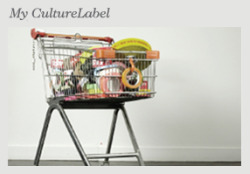“Come And Join Our Community of Culture Shoppers.” That’s one of the taglines employed by the new British site, CultureLabel.com, now in beta, which is self-described this way:
Hello! CultureLabel.com is the first online platform to curate and showcase the best artist-designed and limited-edition products from over 60 leading galleries, museums, artists and culture institutions.
 Though most brands on the site are British, it has invited cultural institutions from around the world, and it looks as if the Museum of Modern Art has signed up, but isn’t present yet. You can read more about CultureLabel in The Art Newspaper, which recently posted an article on its website about it, and the Wall Street Journal, which published an article several days ago.
Though most brands on the site are British, it has invited cultural institutions from around the world, and it looks as if the Museum of Modern Art has signed up, but isn’t present yet. You can read more about CultureLabel in The Art Newspaper, which recently posted an article on its website about it, and the Wall Street Journal, which published an article several days ago.
Sounds like a good idea to me, especially for small museums, but I decided to put Five Questions to an expert on museum merchandising, Rena Zurofsky, who — as you can see on her website — has advised clients like Lincoln Center and the Philbrook Museum.
1) How important are store sales to American museums, and how are sales doing during this recession?
Museum stores have become expected amenities. They support educational missions by selling catalogues and books and…they are considered tools for extending the “brand.” … Whether they actually enhance income or not depends on quite a few factors, not least of which is the level of traffic to the institution itself. Also important will be the popularity or notoriety of a given exhibition. Web sales will enhance the bottom line, but again, generally only if on-line shoppers know to look for that institution. Many shops probably operate at break-even rather than significant revenue-enhancement.
2) CultureLabel.com sounds like something that should exist in the
I am not aware of a parallel, but I agree it is a good idea. In past years there was a retail chain which offered merchandise from different museums. There were some attempted mail order catalogues as well. …The articles state that CultureLabel wishes to expand to include American museums, and I hope they will include museums from other countries as well. It is a really easy and effective way to shop at institutions one can’t get to visit, and in this case a great shop becomes a wonderful entry into a museum’s primary web pages, helping future travelers extend their lists of places to go.
3) Should
I think it is to any museum’s benefit to join CultureLabel from a marketing point of view. As I don’t know their financial arrangements, I can’t speak to that aspect. But since traffic is the primary driver of profitability–assuming you have good product to offer–then this seems an excellent way to help drive international traffic to your shop door.
4) CultureLabel sells the work of contemporary artists, with items costing as low as GPB 400. Could it become an important outlet for artists?
Right now CultureLabel is offering art through gallery connections, rather than directly from the artist. This seems like a more efficient and effective business model than dealing directly with hundreds or thousands of artists. But just as with the small museums, a site like this provides an opportunity for lesser-known artists and galleries to gain new audience and enhance revenues.
5) As you go around the country, aside from your clients, which cultural groups have the best stores in terms of creative offerings?
I’ve been mostly on the eastern seaboard lately so I will just mention a few of the smaller museum stores:
In
The
The New Museum Store has an intriguing assortment of artist books, editions and catalogues.
In
In Florida:
Wolfsonian Museum Store in
In Chicago:
The Renaissance Society of the
